当前位置:网站首页>Brief analysis of tensorboard visual processing cases
Brief analysis of tensorboard visual processing cases
2022-07-03 13:28:00 【Haibao 7】
https://tensorflow.google.cn/tensorboard?hl=zh-cn
TensorBoard Provide visualization functions and tools needed for machine learning experiments :
Track and visualize indicators such as loss and accuracy
Visual model diagram ( Operations and layers )
See the weight 、 Histograms of deviations or other tensors over time
Project the embedding into the lower dimensional space
display picture 、 Text and audio data
analyse TensorFlow Program
And more
TensorBoard It's a separate package ( No pytorch Medium ), The purpose of this package is to visualize the various parameters and results in your model .
Code attached :
import tensorflow as tf
from tensorflow.examples.tutorials.mnist import input_data
max_steps = 1000
learning_rate = 0.001
dropout = 0.9
data_dir = './MNIST_data_bak'
log_dir = './logs/mnist_with_summaries'
mnist = input_data.read_data_sets(data_dir, one_hot=True)
sess = tf.InteractiveSession()
with tf.name_scope('input'):
x = tf.placeholder(tf.float32, [None, 784], name='x-input')
y_ = tf.placeholder(tf.float32, [None, 10], name='y-input')
with tf.name_scope('input_reshape'):
# 784 The dimension is deformed to keep the image to the node
# -1 Represents the number of pictures coming in 、28,28 Is the height and width of the picture ,1 Is the color channel of the picture
image_shaped_input = tf.reshape(x, [-1, 28, 28, 1])
tf.summary.image('input', image_shaped_input, 10)
# Define the initialization method of neural network
def weight_variable(shape):
initial = tf.truncated_normal(shape, stddev=0.1)
return tf.Variable(initial)
def bias_variable(shape):
initial = tf.constant(0.1, shape=shape)
return tf.Variable(initial)
# Definition Variable Variable data summary function , We calculate the mean、stddev、max、min
# Use... For these scalar data tf.summary.scalar Record and summarize
# Use tf.summary.histogram Record variables directly var Histogram data
def variable_summaries(var):
with tf.name_scope('summaries'):
mean = tf.reduce_mean(var)
tf.summary.scalar('mean', mean)
with tf.name_scope('stddev'):
stddev = tf.sqrt(tf.reduce_mean(tf.square(var - mean)))
tf.summary.scalar('stddev', stddev)
tf.summary.scalar('max', tf.reduce_max(var))
tf.summary.scalar('min', tf.reduce_min(var))
tf.summary.histogram('histogram', var)
# To design a MLP Multilayer neural network to train data
# The model data is summarized in each layer
def nn_layer(input_tensor, input_dim, output_dim, layer_name, act=tf.nn.relu):
with tf.name_scope(layer_name):
with tf.name_scope('weights'):
weights = weight_variable([input_dim, output_dim])
variable_summaries(weights)
with tf.name_scope('biases'):
biases = bias_variable([output_dim])
variable_summaries(biases)
with tf.name_scope('Wx_plus_b'):
preactivate = tf.matmul(input_tensor, weights) + biases
tf.summary.histogram('pre_activations', preactivate)
activations = act(preactivate, name='activation')
tf.summary.histogram('activations', activations)
return activations
# We use the function just defined to create a neural network , The input dimension is the size of the picture 784=28*28
# The output dimension is the number of hidden nodes 500, Create another Dropout layer , And use tf.summary.scalar Record keep_prob
# And then use nn_layer Define the neural network output layer , Its input dimension is the number of hidden nodes in the upper layer 500, The output dimension is the number of categories 10
# At the same time, the activation function is congruent mapping identity, Temporarily not used softmax
hidden1 = nn_layer(x, 784, 500, 'layer1')
with tf.name_scope('dropout'):
keep_prob = tf.placeholder(tf.float32)
tf.summary.scalar('dropout_keep_probability', keep_prob)
dropped = tf.nn.dropout(hidden1, keep_prob)
y = nn_layer(dropped, 500, 10, 'layer2', act=tf.identity)
# Use tf.nn.softmax_cross_entropy_with_logits() Analyze the results of the previous output layer Softmax
# Process and calculate the cross entropy loss cross_entropy, Calculate the average loss , Use tf.summary.scalar Make statistical summary
with tf.name_scope('cross_entropy'):
diff = tf.nn.softmax_cross_entropy_with_logits(logits=y, labels=y_)
with tf.name_scope('total'):
cross_entropy = tf.reduce_mean(diff)
tf.summary.scalar('cross_entropy', cross_entropy)
# Use Adam The optimizer optimizes the loss , At the same time, the number of correctly predicted samples is counted and the accuracy rate is calculated accuracy, Summary
with tf.name_scope('train'):
train_step = tf.train.AdamOptimizer(learning_rate).minimize(cross_entropy)
with tf.name_scope('accuracy'):
with tf.name_scope('correct_prediction'):
correct_prediction = tf.equal(tf.argmax(y, 1), tf.argmax(y_, 1))
with tf.name_scope('accuracy'):
accuracy = tf.reduce_mean(tf.cast(correct_prediction, tf.float32))
tf.summary.scalar('accuracy', accuracy)
# Because we have defined too many tf.summary Summary operation , It is too troublesome to perform these operations one by one ,
# Use tf.summary.merge_all() Get all summary operations directly , For later execution
merged = tf.summary.merge_all()
# Define two tf.summary.FileWriter The file recorder has different subdirectories , It is used to store the log data of training and testing respectively
train_writer = tf.summary.FileWriter(log_dir + '/train', sess.graph)
test_writer = tf.summary.FileWriter(log_dir + '/test')
# meanwhile , take Session Calculation chart sess.graph Join the training process , So again TensorBoard Of GRAPHS It can be displayed in the window
# Visualization of the whole calculation diagram , Finally, initialize all variables
tf.global_variables_initializer().run()
# Definition feed_dict function , If it's training , Need to set up dropout, If it's a test ,keep_prob Set to 1
def feed_dict(train):
if train:
xs, ys = mnist.train.next_batch(100)
k = dropout
else:
xs, ys = mnist.test.images, mnist.test.labels
k = 1.0
return {
x: xs, y_: ys, keep_prob: k}
# Executive Training 、 test 、 Logging operations
# Save the model created by
saver = tf.train.Saver()
for i in range(max_steps):
if i % 10 == 0:
summary, acc = sess.run([merged, accuracy], feed_dict=feed_dict(False))
test_writer.add_summary(summary, i)
print('Accuracy at step %s: %s' % (i, acc))
else:
if i % 100 == 99:
run_options = tf.RunOptions(trace_level=tf.RunOptions.FULL_TRACE)
run_metadata = tf.RunMetadata()
summary, _ = sess.run([merged, train_step], feed_dict=feed_dict(True))
train_writer.add_run_metadata(run_metadata, 'step%03d' % i)
train_writer.add_summary(summary, 1)
saver.save(sess, log_dir + 'model.ckpt', i)
print('Adding run metadata for', i)
else:
summary, _ = sess.run([merged, train_step], feed_dict=feed_dict(True))
train_writer.add_summary(summary, i)
train_writer.close()
test_writer.close()
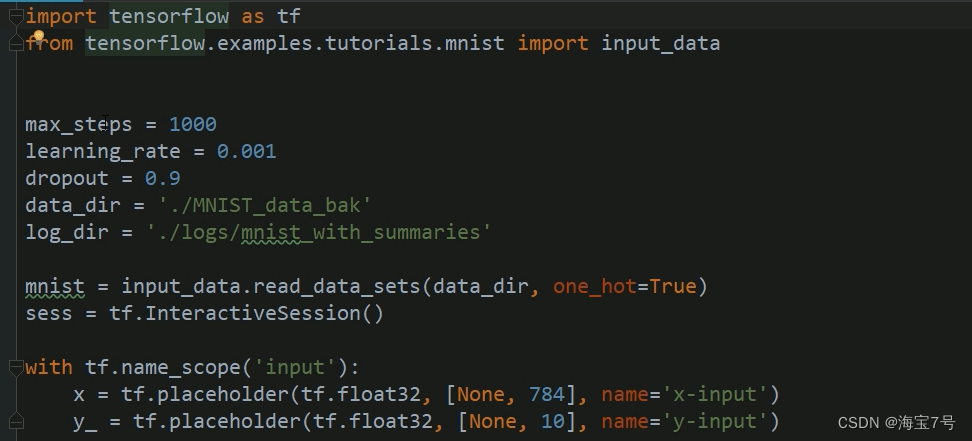
Training process 
Advanced usage operations 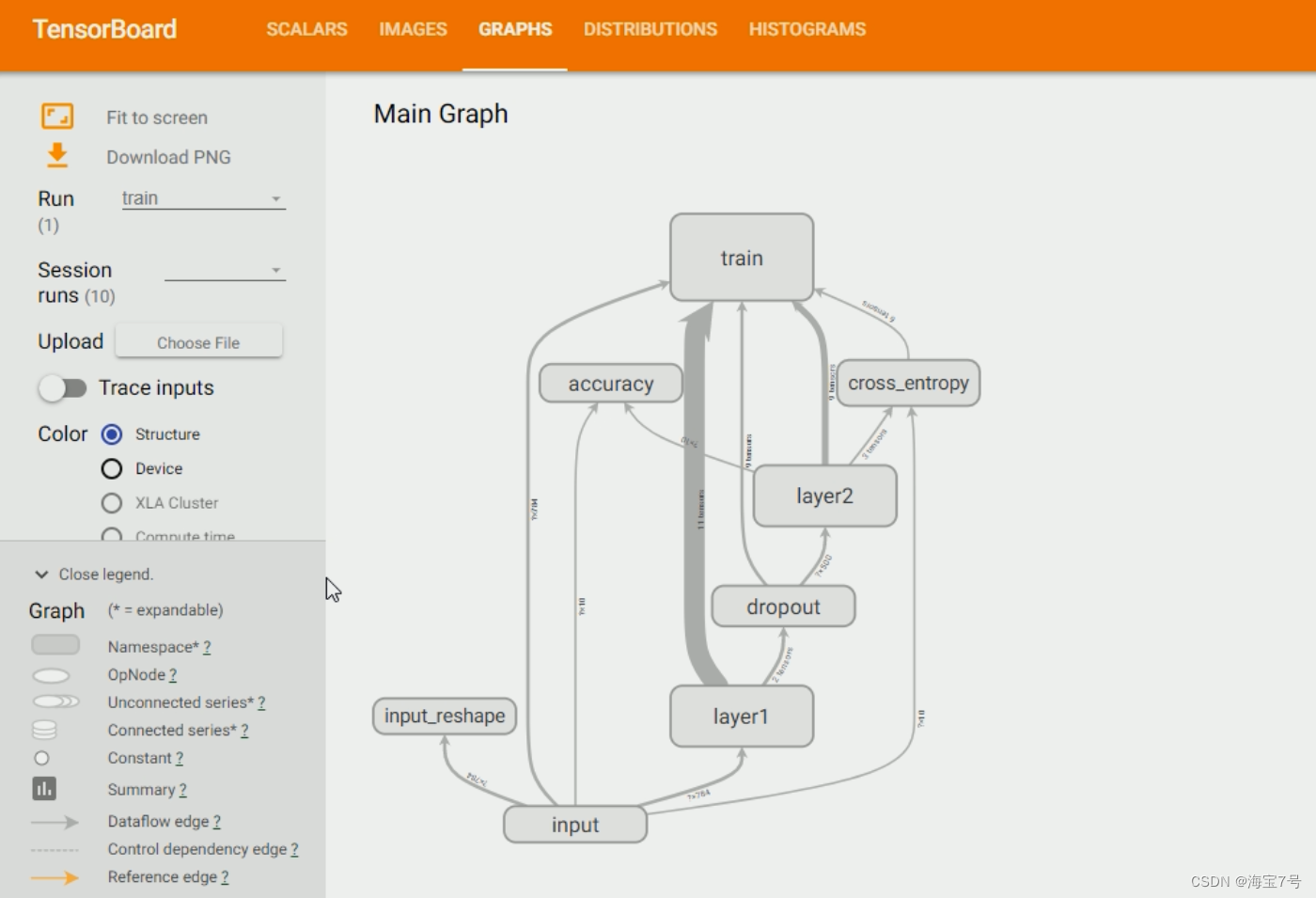
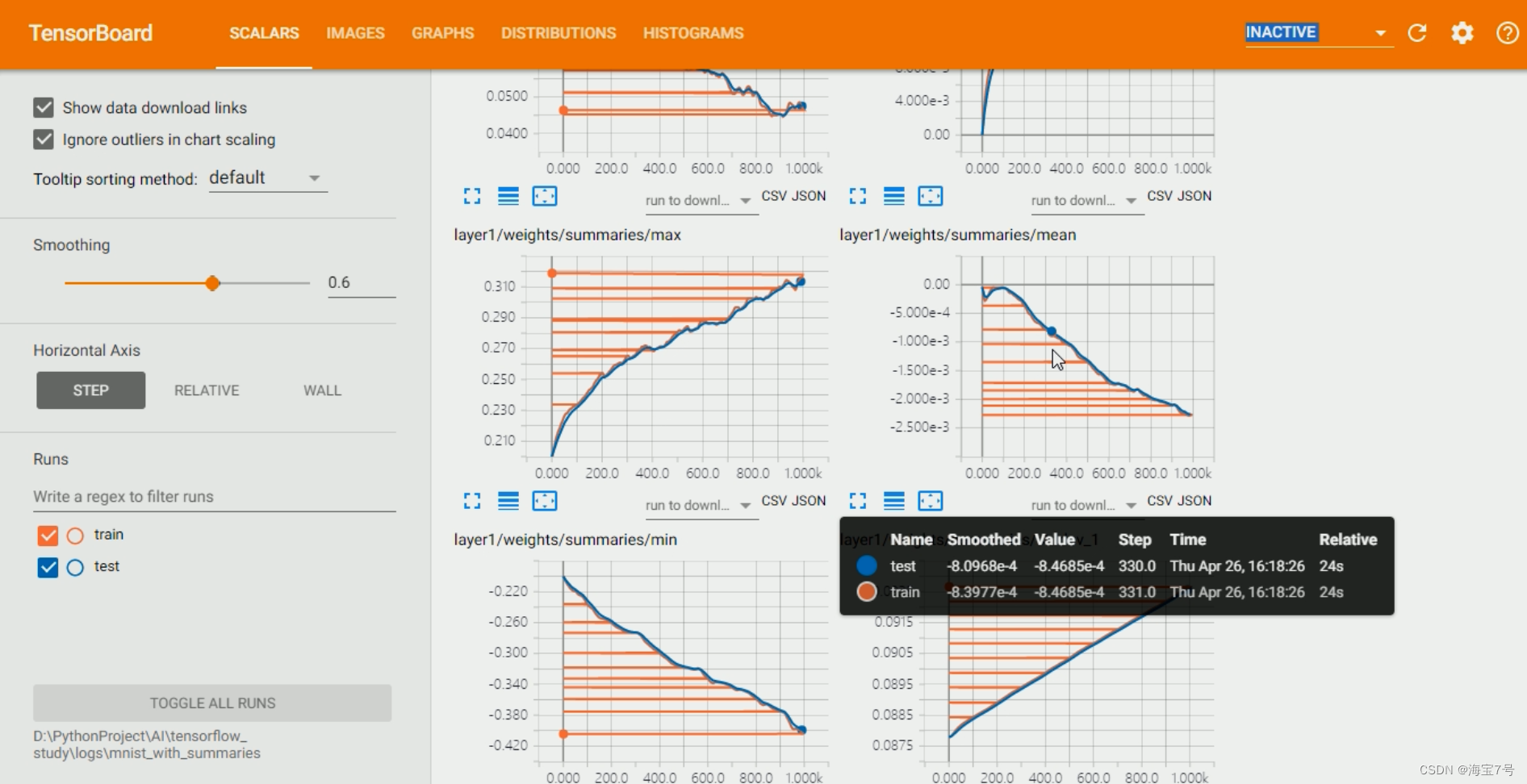
Personally feel , Still need self-study , Or there is a leader , Otherwise, the starting process and subsequent processing are more troublesome .
TensorBoard Visual tools simple tutorial reference
https://blog.csdn.net/qq_41573860/article/details/106674370
long-range tensorboard
Because of the conditions , Usually, deep learning is conducted on a remote server , utilize SSH Direction Tunnel Technology , Forward the port data on the server to the corresponding local port , Then you can log data on the local method server .
Reference resources :https://blog.csdn.net/zhaokx3/article/details/70994350
边栏推荐
- MapReduce实现矩阵乘法–实现代码
- Error handling when adding files to SVN:.... \conf\svnserve conf:12: Option expected
- 今日睡眠质量记录77分
- [Database Principle and Application Tutorial (4th Edition | wechat Edition) Chen Zhibo] [Chapter 6 exercises]
- [Database Principle and Application Tutorial (4th Edition | wechat Edition) Chen Zhibo] [Chapter IV exercises]
- 【电脑插入U盘或者内存卡显示无法格式化FAT32如何解决】
- 2022-02-11 practice of using freetsdb to build an influxdb cluster
- Start signing up CCF C ³- [email protected] chianxin: Perspective of Russian Ukrainian cyber war - Security confrontation and sanctions g
- The difference between stratifiedkfold (classification) and kfold (regression)
- Today's sleep quality record 77 points
猜你喜欢

Sitescms v3.1.0 release, launch wechat applet
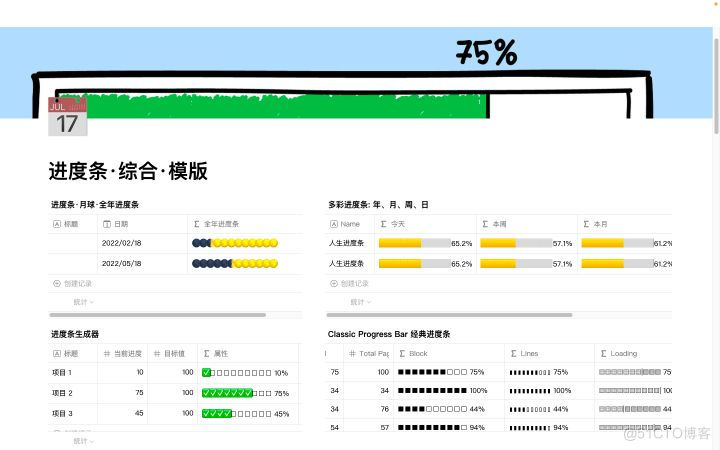
双链笔记 RemNote 综合评测:快速输入、PDF 阅读、间隔重复/记忆

Logseq 评测:优点、缺点、评价、学习教程

【历史上的今天】7 月 3 日:人体工程学标准法案;消费电子领域先驱诞生;育碧发布 Uplay
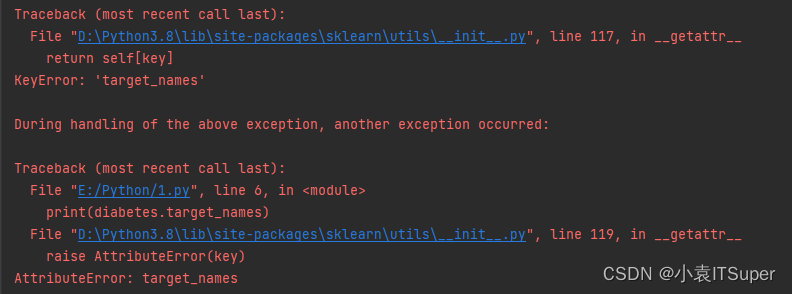
已解决(机器学习中查看数据信息报错)AttributeError: target_names

When we are doing flow batch integration, what are we doing?
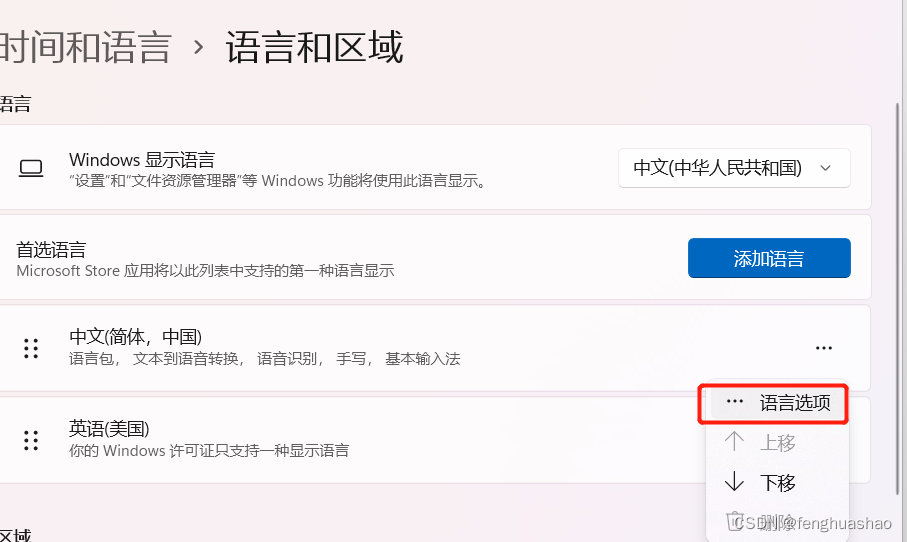
Idea full text search shortcut ctr+shift+f failure problem

MySQL installation, uninstallation, initial password setting and general commands of Linux

【电脑插入U盘或者内存卡显示无法格式化FAT32如何解决】

Setting up remote links to MySQL on Linux
随机推荐
Tutoriel PowerPoint, comment enregistrer une présentation sous forme de vidéo dans Powerpoint?
json序列化时案例总结
The R language GT package and gtextras package gracefully and beautifully display tabular data: nflreadr package and gt of gtextras package_ plt_ The winloss function visualizes the win / loss values
双链笔记 RemNote 综合评测:快速输入、PDF 阅读、间隔重复/记忆
2022-02-09 survey of incluxdb cluster
今日睡眠质量记录77分
DQL basic query
R语言gt包和gtExtras包优雅地、漂亮地显示表格数据:nflreadr包以及gtExtras包的gt_plt_winloss函数可视化多个分组的输赢值以及内联图(inline plot)
The network card fails to start after the cold migration of the server hard disk
[colab] [7 methods of using external data]
MySQL functions and related cases and exercises
正则表达式
2022-01-27 redis cluster cluster proxy predixy analysis
MySQL
[sort] bucket sort
Luogup3694 Bangbang chorus standing in line
Internet of things completion -- (stm32f407 connects to cloud platform detection data)
JSON serialization case summary
In the promotion season, how to reduce the preparation time of defense materials by 50% and adjust the mentality (personal experience summary)
stm32和电机开发(从mcu到架构设计)